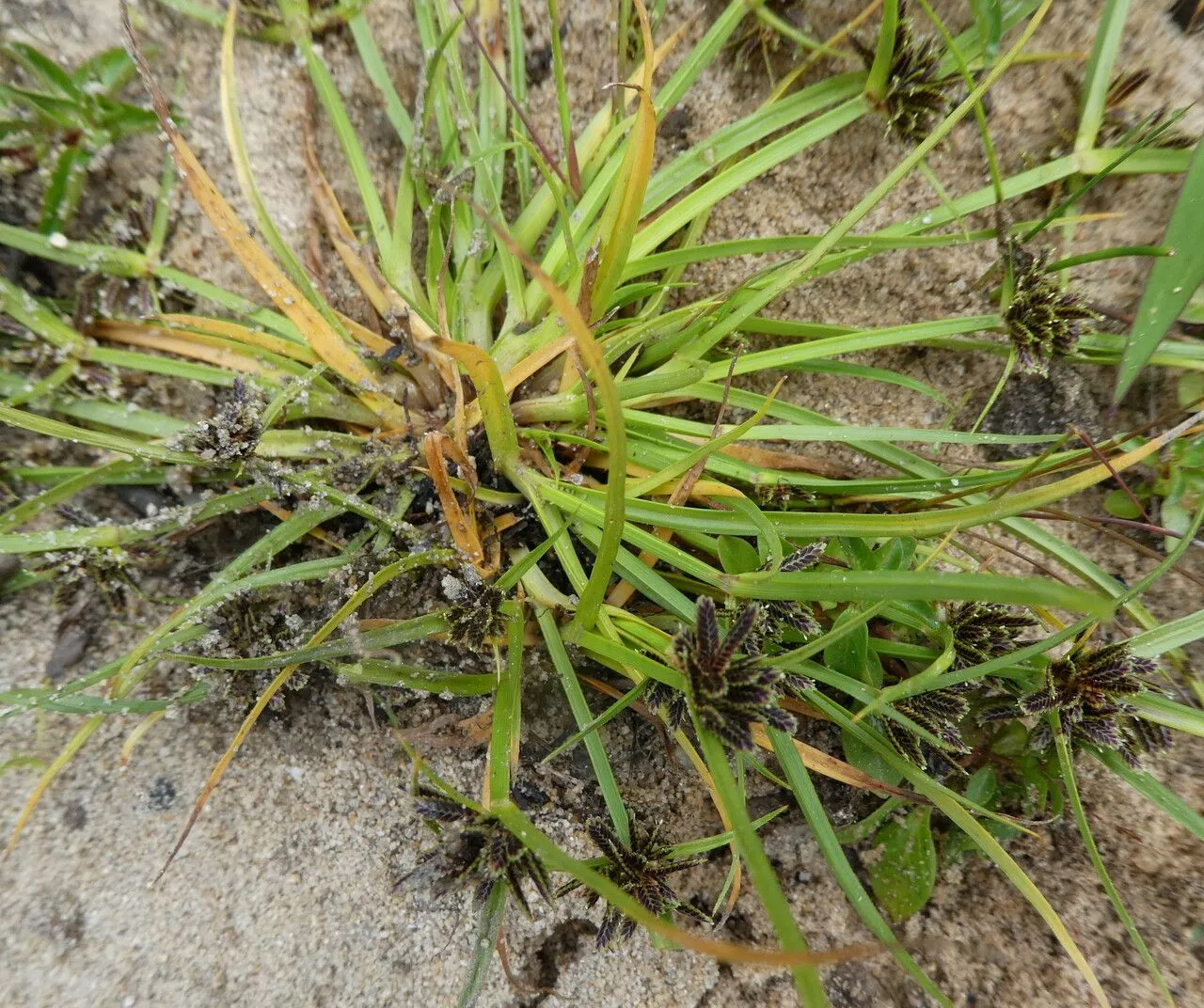
Author: L.
Bibliography: Sp. Pl.: 46 (1753)
Year: 1753
Status: accepted
Rank: species
Genus: Cyperus
Vegetable: False
Observations: Macaronesia, Europe, Medit. to China
The Brown Flatsedge, known scientifically as Cyperus fuscus, is a notable species within the Cyperaceae family. First described by Carl Linnaeus in his seminal work “Species Plantarum” in 1753, this plant has secured its place in botanical literature and continues to be of interest to botanists and nature enthusiasts alike.
Cyperus fuscus, commonly referred to as the Brown Flatsedge, is a perennial herb that is widely distributed across various regions. Its natural habitat spans from Macaronesia and Europe through the Mediterranean region and stretches as far east as China. This broad geographic range illustrates the plant’s adaptability to diverse climatic conditions and soil types.
In terms of appearance, the Brown Flatsedge exhibits the typical characteristics of the Cyperaceae family. It generally features grass-like leaves and stem structures that are often triangular in cross-section. The flower heads, or inflorescences, are brownish and inconspicuous, blending seamlessly into the surrounding environment. This coloration is a defining attribute of the species and contributes to its common name.
Cyperus fuscus thrives in a variety of habitats but is frequently found in wet, marshy areas and along the edges of water bodies. Its ecological role in these ecosystems is significant, as it helps to stabilize soil and provide habitat for a variety of wildlife. The plant’s ability to grow in such moist environments makes it an essential component of wetland biodiversity.
Conservationists and botanists have noted the importance of Cyperus fuscus in maintaining ecological balance. Its presence indicates healthy, functioning wetland ecosystems, which are vital for flood control, water purification, and providing sanctuary for a myriad of plant and animal species.
As with many plant species, the Brown Flatsedge faces challenges from habitat loss and environmental changes. Efforts to preserve wetlands and protect this species’ natural habitats are crucial for its continued survival.
In summary, the Brown Flatsedge (Cyperus fuscus) is a resilient and ecologically important species within the Cyperaceae family. Its extensive range from Macaronesia through Europe and the Mediterranean to China speaks to its adaptability and ecological value. First described by Linnaeus in 1753, this plant remains a subject of interest for its role in wetland habitats and its contribution to biodiversity. Conservation efforts are essential to ensure that this unassuming yet vital plant continues to thrive in its natural habitats.
Deu: braunes zypergras, schwarzbraunes zypergras
Eng: brown flatsedge, brown galingale, black cyperus, brown cyperus, brown umbrella sedge
Dan: brun fladaks
Nld: bruin cypergras
Lav: brunais dizmeldrs
Swe: dvärgag
Fra: souchet brun, souchet brun noirâtre
Nob: dvergak
Nno: dvergak
Ara: se’ed
Cym: ysnoden fair lwytgoch, ysnoden-fair lwytgoch
En: Brown flatsedge, Brown galingale, Black Cyperus, Brown Cyperus, Brown umbrella sedge
Ar: سعد (سِعْد), سعد (سِعْد، سَعْد)، ديس (دِيس), سمار (سَمار، سُمار), Se’ed
Ca: Serrana fosca
Da: Brun fladaks
Nl: Bruin cypergras
Fr: Souchet brun, Souchet brun noirâtre
De: Braunes Zypergras, Schwarzbraunes Zypergras, Schwarzbraunes Cypergras
He: גומא חום
It: Zigolo nero
Lv: Brunais dizmeldrs
Nb: Dvergak
Nn: Dvergak
Sv: Dvärgag
Cy: Ysnoden Fair Lwytgoch, Ysnoden-Fair Lwytgoch
Taken Sep 9, 2017 by Yoan MARTIN (cc-by-sa)
Taken Sep 18, 2019 by Daniel Bourget (cc-by-sa)
Taken Sep 9, 2017 by Yoan MARTIN (cc-by-sa)
Taken Sep 4, 2022 by Fabrice Rubio (cc-by-sa)
Taken Nov 26, 2021 by Llandrich anna (cc-by-sa)
Taken Sep 29, 2022 by Radoslav Marinkovic (cc-by-sa)
Taken Sep 4, 2022 by Fabrice Rubio (cc-by-sa)
Taken Sep 29, 2022 by Radoslav Marinkovic (cc-by-sa)
Taken Nov 26, 2021 by Llandrich anna (cc-by-sa)
Taken Nov 26, 2021 by Llandrich anna (cc-by-sa)
Taken Aug 10, 2017 by Yoan MARTIN (cc-by-sa)
Taken Aug 9, 2013 by Tela Botanica − Emmanuel STRATMAINS (cc-by-sa)
Taken Sep 9, 2017 by Yoan MARTIN (cc-by-sa)
Taken Sep 9, 2017 by Yoan MARTIN (cc-by-sa)
Taken Aug 9, 2013 by Tela Botanica − Emmanuel STRATMAINS (cc-by-sa)
Taken Sep 4, 2022 by Fabrice Rubio (cc-by-sa)
Taken Sep 12, 2021 by Fabrice Rubio (cc-by-sa)
Taken Sep 4, 2022 by Fabrice Rubio (cc-by-sa)
Taken Nov 1, 2021 by Aurélie G. (cc-by-sa)
Taken Sep 4, 2022 by Fabrice Rubio (cc-by-sa)
Taken Sep 15, 2009 by Photoflora – Benoit BOCK (©)
Taken Aug 31, 1847 by Tela Botanica − Anne-Marie GRIMAUD (cc-by-sa)
Taken Jan 1, 1800 by Tela Botanica − Daniel MATHIEU (cc-by-sa)
Taken Jan 1, 1970 by Photoflora – L’Abbé COSTE (©)
Taken Jul 31, 1871 by Tela Botanica − Herbier PONTARLIER-MARICHAL (cc-by-sa)
Taken Mar 1, 2020 by Vinicius Saragiotto (cc-by-sa)
© copyright of the Board of Trustees of the Royal Botanic Gardens, Kew.
© copyright of the Board of Trustees of the Royal Botanic Gardens, Kew.
© copyright of the Board of Trustees of the Royal Botanic Gardens, Kew.
Growth habit: Graminoid
Ph maximum: 6.5
Ph minimum: 5.5
Light: 8
Atmospheric humidity: 8
Bloom months: [‘jul’, ‘aug’, ‘sep’]
Soil nutriments: 5
Family: Myrtaceae Author: (F.Muell.) K.D.Hill & L.A.S.Johnson Bibliography: Telopea 6: 402 (1995) Year: 1995 Status:…
Family: Rubiaceae Author: Pierre ex A.Froehner Bibliography: Notizbl. Bot. Gart. Berlin-Dahlem 1: 237 (1897) Year:…
Family: Sapindaceae Author: Koidz. Bibliography: J. Coll. Sci. Imp. Univ. Tokyo 32(1): 38 (1911) Year:…
Family: Asteraceae Author: A.Gray Bibliography: Pacif. Railr. Rep.: 107 (1857) Year: 1857 Status: accepted Rank:…
Family: Fabaceae Author: Medik. Bibliography: Vorles. Churpfälz. Phys.-Ökon. Ges. 2: 398 (1787) Year: 1787 Status:…
Family: Aspleniaceae Author: (Cav.) Alston Bibliography: Bull. Misc. Inform. Kew 1932: 309 (1932) Year: 1932…